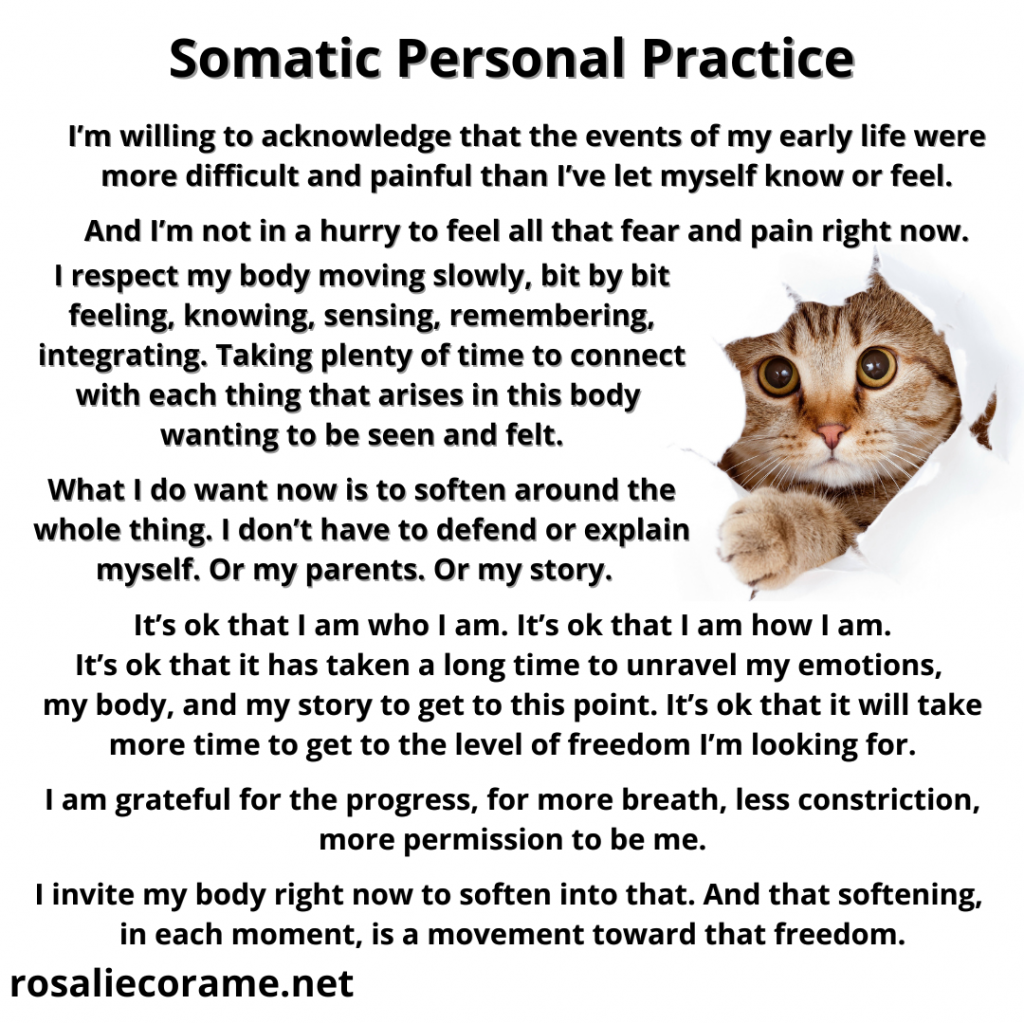I’m relieved, grateful and excited that Spring is landing!
I can feel mushiness and delight in my heart with the warming days, and my walks are becoming more frequent and more comfortable. The persistent fatigue I mentioned in my last newsletter is also easing, and my body feels really grateful for that.

I’ve been thinking a lot – and feeling a lot – about connection, relationship, and relational trauma. Attachment. Attachment styles, attachment “disorder,” attachment needs. Early unmet attachment needs leading to significant personality disorganization and lifelong inner stress and chaos. (That’s me and most of my clients.)
Speaking of my clients, I do still have space in my practice and, if we are a good fit, the experience and the shifts can be quite magical. The link to schedule a Discovery Call is below. Please forward this email or provide my website address if there is someone in your life who seems to suffer from inner chaos and who might be interested in connecting, or interested simply in using the resources I’m creating. Thank you!!
Back to my train of thought. I was thinking that while there is a lot of relational work going on in the sessions with my clients – whether it is called out our not – that among the audio and video resources I’ve created, none of them are explicitly focused on relationship and attachment.
So I made a new video, playing with the postures of attachment.
I discuss and share that video with you below. This newsletter also includes a long answer to the question: “What are we trying to do or effect inside a person when we are doing ‘trauma healing’?”
First, the video.
It seems pretty clear that most or all people who have developmental trauma also have relational trauma, whether or not the developmental trauma was caused by dysfunctional caregivers. For example, even someone with wonderfully attentive parents is likely to experience significant relational trauma if they have any prolonged separation from their parents due to sickness, work, war, hospitalization, or any other cause.
This video shows me playing with three relational postures. For those of you who won’t watch the video (I admit I rarely watch videos others share with me!), here are the cliff notes.



The invitation is that when you are in touch with activation or distress, that you first find some connection to support and safety within or without, as you are able to. Feel the distress and also feel the support or safety.
Then try on the first posture above, hands out, holding a boundary, possibly pushing away.
This is directed to people who (possibly despite their best intentions), if they approached, would cause the distress to be worse, not better. Note that this is not necessarily about the present, as our present distress is almost always an emotional reference to earlier experiences that felt similarly in our bodies. So the holding a boundary can be for the present or for the past or for both.
Feel it. “I keep out of my space those who would make it worse for me. I get to choose who to have close to me. I can choose to have no one close to me if I wish.”
Then try the posture of palms up, hands out in front, possibly first reverting to just being with the challenging feelings and support.
This second posture is directed to the people (real, imaginary, embodied, in spirit) who might have something sweet, supportive, helpful and attuned to offer. Those who might actually meet each of us the way we have longed to be met. My invitation to you in trying on this posture is to feel a sense of “Perhaps you will receive me, perhaps you will bring me some kindness.” Again, of course, this tends to be as much or more about the past than the present.
And finally, both arms up. This is again about being received, but it’s about being received and supported by the Universe, by Nature, by the Earth, rather than by humans.
If you try playing with these postures, I’m curious about what happens for you. Feel free to reach out to me with any interesting experiences. What I noticed was that after working with these postures for a few days in the way I describe in the video, my breath deepened. I have had a deeper organic breath more of the time, that has persisted over the past few weeks. I can’t be sure that these practices were the cause of that change, but they did seem to be the thing that prompted the shift in my body.
Here is the link to the video. It’s about 20 minutes in length.
This is sweet: when I went to YouTube for the video link, I noticed that I have 70 YouTube subscribers and that this video has been seen 17 times even though I have only shared it with one person. I am becoming somebody!

So, the rest of the content of this newsletter is a lengthy answer to the questions: “When doing ‘trauma healing’ work, what are the shifts or changes that are intended or expected to happen for the person? What are we trying to do, change, shift, open?”
Here is an incomplete list of shifts that can and do happen in effective developmental trauma healing work, wherever and however that work is done and regardless of whether these elements are consciously called out or even consciously known by the person holding the work.
For sure, all of these changes have occurred incrementally in me over time, throughout the past 30 years and continuing in recent months and weeks. And I see these changes in my clients, at varying paces, and not necessarily in all categories at once.
As you are reviewing these categories of change, I invite you to pause and notice within yourself whether each type of change has occurred in you over time. If yes, maybe pause to really feel into how it is different now than it was when you started your journey.

Here you go!
What are the intentions and goals
of “trauma healing” in people?
Emotional Safety/Attachment
The experience of feeling emotionally safe (enough) with the facilitator and/or group, feeling they are accepted and seen, and have permission to be themself.
Then based on that baseline, a (likely gradual) increase in emotional safety over time, where (at least some part of) the person is able to believe that it’s ok to be who they are and feel what they feel, and they also can feel that the facilitator and/or group will continue to be accepting and supportive (enough) of them even as they reveal more painful material about who they are and what they feel.

Experiencing Neutral and Positive Things
Creating or expanding capacity to feel things that feel good or ok.
Some people have little or no capacity for feeling ok. The bad feelings and feelings of threat are so intense that it feels like anything good or ok is impossible or can’t be real. Some people can feel ok for moments, but then the ok feeling triggers an increased sense of danger, like the calm before the storm. Or some people can tolerate feeling ok or neutral but if they feel actively good or excited or hopeful, those feelings then trigger dread or danger.
Looking for, paying attention to, and staying longer with things that feel good or ok.
Some people can tolerate feeling good or ok, but they miss the chance to feel good or ok because their attention is always habitually focused on seeking out and mitigating threats. So we invite the practice of slowing down and intentionally noticing and seeking out things that feel good or ok.

Connection with the Body
Creating or expanding the ability to notice what is happening in the body: physical pain, discomfort or bodily needs; both good and bad feelings that express in part through bodily sensations; impulses or desires felt in the body; constriction, bracing, holding, openness, flow, breath.
Creating or expanding the ability to send communications to the body: inviting breath, ease, grounding, or movement; gently sitting with organs, systems, or any body part to both explore what is present and to invite useful shifts.

Safety, Support and Connection Generally
Creating or expanding the person’s/body’s ability and capacity to feel relatively safe, supported and connected. This may include but is not limited to the relational connection with the facilitator or group that was mentioned above.

Making Contact with Difficult Emotions, always while connected to a relative experience of safety and connection.
Making initial contact with specific emotions that had been hidden.
Gradually deepening and expanding contact with painful emotions that are known. Expressing what wants to be expressed (as long as it’s not a habitual expression of the same feelings and content repeatedly as generally these habitual feelings are hiding other deeper feelings and this repeated expression doesn’t help except for momentary relief.)

Disidentifying; that is, maintaining a witness or observer part of the self that can know that their overwhelming emotional experience is “just” an emotional experience and is not all there is.
Helping the body to learn that overwhelming emotions can be survived, that those emotions don’t actually bring the annihilation that it feels like they are bringing.

Reconnecting Undercouplings/Sense of Self: I matter
Incrementally increasing access to the following qualities and “knowing” within the body:
Locating hope.
The fire of life force; “I am alive!, I’m here!, I matter!”
Boundaries, the right and capacity to claim personal space.
Sense of self: “I am, I know who I am, I am the authority on me.”
“I feel things, I want things, I need things, I have values.”


Uncoupling Overcouplings
Incrementally being able to relate to challenging situations without being thrown off balance by emotions, by supporting the body to realize that the situation and emotion are not inherently bound together.
In particular, separating intense emotions from situations, such as:
Uncoupling fear from immobility
Uncoupling frustration, anger, or helplessness from the disappointments in other people’s behaviors
Uncoupling shame/feeling of failure from personal challenges/lack of progress
Uncoupling loneliness, grief or longing from relationship losses, lacks and challenges

Freeing the Body
Incrementally reducing unconscious habitual clenching and bracing postures in the musculature.
Incrementally reducing ways in which parts of the body or body systems are offline, not fully functioning.

I wish for you a safe and fruitful spring.
May inequity be addressed, may peace be built, may possibilities be available to all, and may we each find our way and do our part to support those things happening.


